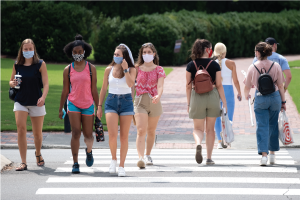UNC Hussman research key to North Carolina’s COVID-19 messaging

By Beth Hatcher
People turned to local media for COVID-19 information.
People worried about others’ health as much as their own.
People wondered what settings didn’t require a mask.
Those are just some of the insights that UNC Hussman School of Journalism and Media researchers found that directly influenced how North Carolina’s governmental agencies disseminated pandemic information to the public.
UNC Hussman Dean Susan King explored the research and its reach during the school’s virtual discussion “What Have We Learned About Audience Engagement in the Age of COVID?” on March 25, 2021, with W. Horace Carter Distinguished Professor Francesca Dillman Carpentier, E. Reese Felts Jr. Distinguished Associate Professor Allison Lazard and Roy H. Park Fellow and Ph.D. student Rhyan Vereen.
“Living through this COVID-19 pandemic … it has upended so many facets of our existence … and it’s created new information needs that we never could have foreseen,” Carpentier said at the conversation’s start, referencing several research studies that showed an increase in news consumption, specifically from local and regional sources, throughout the pandemic.
As citizens looked for information about COVID-19, the North Carolina Department of Health and Human Services looked to UNC Hussman, reaching out for assistance with its COVID-19 messaging. At first, the Hussman-led team that featured 27 faculty and students from across the University focused on social distancing messaging, eventually expanding their efforts to messaging that promoted mask wearing.
“We got a call from NCDHHS Secretary Mandy Cohen’s office saying they needed evidence-based messages, they needed to know what North Carolinians wanted to hear to encourage social distancing,” said Lazard, who led the team.
The research findings then influenced a range of governmental messaging, from press conferences to public service announcements.
“We really recommended a positive message over a punitive message, a message that signaled autonomy and that people had a choice,” said team member Vereen, who also noted the importance of messaging that doled out practical information like where people could get masks and when people could get vaccines.
The findings also had the very tangible result of increasing the number of masks in the City of Durham’s supply after Lazard shared with Durham officials the research finding that people wanted more than one mask so they could always have one handy.
“That tells a story about how scholarship can have an impact in the real world, right here in North Carolina, and that’s what’s so exciting,” King said.
Carpentier responded to a question about misinformation with advice to look for tell-tale misinformation signs like misspellings and sensationalist language in news stories. Lazard fielded a question about negative messages in COVID-19 media coverage by stressing that public health messaging should stay cautious.
“There’s a great deal of caution not to be too positive too early, because you don’t want people to go back to normal and reverse the trend,” Lazard said. “It’s about finding that balance between hope and the fact that people are still suffering.”
One hope Lazard expressed was that fast, nimble research methods utilizing Zoom and other COVID-necessitated tools become more commonplace in future research, even after the pandemic ends.
“I think about research fundamentally different now,” Lazard said. “How can we make research more accessible to who we want to hear from?”
Carpentier praised the impact of such conversations about the reach of UNC Hussman research: “I think it’s exceedingly important to communicate the findings and insights from the important research our faculty and students are doing, because it’s our duty as responsible scholars and members of the community to ensure as many people as possible can benefit from our work,” she said. “What we’ve learned specifically from the research around COVID can help others cope with the stress, reduce their uncertainty over how to protect themselves, and move toward normality.”